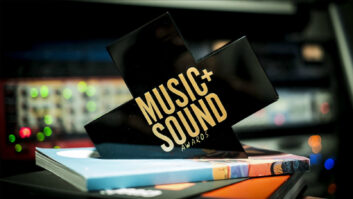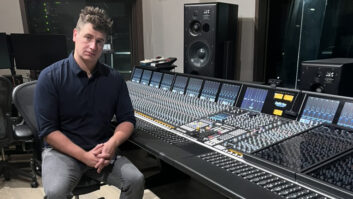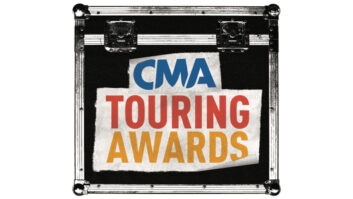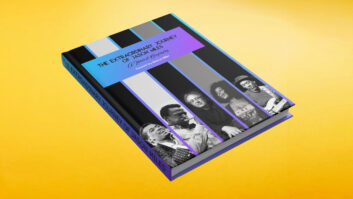Marcus Miller is taking a breather. It won’t last long, though, because his calendar is already full. He’s in the midst of mixing the upcoming Take 6 release, which he also produced. After that, he hits the road to support his latest solo album, M2, a typically nifty mix of jazz and R&B. And no doubt he’ll be hunkered down at his own Hannibal Studios writing, producing and polishing a new collection of music after that.
The Marcus Miller run — and we do mean run — began in earnest 25 years ago, when he got back from a tour with drummer Lenny White. The young bassist was a studio veteran by the time he was 20 and has since played on well over 400 releases. His production career began in 1980 with jazz saxophonist David Sanborn’s Grammy award-winning Voyeur.
The Sanborn collaboration was just one of many that Miller remembers fondly. His own greatest hits list include dates with Luther Vandross, McCoy Tyner, George Benson, Earl Klugh, Aretha Franklin, Roberta Flack, Grover Washington Jr. and Miles Davis. “I remember sessions where the musicianship was high,” he says. “Those sessions also featured an artist with an unmistakable sound — a sound that I’d been listening to on a record all my life. Then to sit there in the studio and hear it coming out of a real person, that was always a trip.”
For the young Miller, playing Miles Davis’ band was a key formative experience. In fact, Miller says it was during his first sessions with Miles when he found his own sound. “It was a place where I really didn’t feel comfortable playing like anybody else, because it was Miles,” he recalls. “Why would you waste an opportunity playing with Miles playing like somebody else or playing somebody else’s licks? So, I was really closing my eyes and trying to dig deep and find things that were right for the music.”
After playing bass in Davis’ band, Miller got a chance to produce the legend, which was, not surprisingly, a bit intimidating for a young man. “Oh yeah, especially at the beginning,” he admits. Miller had written some songs for Davis’ 1986 Warner Bros. “comeback” debut and started to overdub the tracks in the studio. “Miles ended up coming in three days later, and I was wondering if he was going to dig it,” Miller recalls. “This was going to be pretty intense, but he came in and loved it. He said, ‘Keep going. I’ll come in tomorrow and play.’ When he came in to play, it was a little tough for me at first, because I wasn’t that willing to give him direction. Halfway through, he said, ‘Look, you have to tell me what to do. You wrote this, you know how it’s supposed to sound. Don’t hesitate.’ So I began to gingerly give him some direction.”
The duo continued working together for the Davis releases, Music From Siesta and Amandla. Miller grew more confident as the sessions progressed: “I was really taking charge by the end,” he says. “After a couple albums, he began to trust me, and I began to feel comfortable about it. So we went in, and it became a lot of fun.”
It was during those sessions with Miles that Miller discovered his production philosophy, which he now brings along into any session he produces. “For me, in producing you basically fill in whatever needs to be filled in,” he adds. “If I’m producing an artist and all they do is sing, then I’m in charge of finding the songs, performing the songs, or getting musicians to perform the songs, picking the studio, getting the background singers. If I’m working with someone like Luther Vandross, who has so many talents himself, I just basically fill in whatever is necessary.”
During sessions with Vandross, they will discuss songs and approaches, though Vandross usually has a clear idea of how a song should sound. “So I’m basically another ear for him to bounce ideas off of,” Miller explains. “Since we’ve been working together for so long, I have a pretty good idea of what he likes. We both like the same things, so it makes it easier. I’m his secondary ears, and in terms of the arrangements, I’ll do that and I’ll help pull the musicians together. Basically whatever talents you have, you use to get the record done. Based on who the artist is, you’ll have more or less responsibility.”
The a cappella group Take 6 was more of a head-scratcher: “The challenge was how to preserve what they’ve built up over all these years in terms of their sound, but maybe add some instruments and give them something a little bit different. So the arrangement was really important, making sure that things were full enough to add some interest, but sparse enough to not detract from what makes them great. With Take 6, I was also concerned with just making sure that I added just the right amount of instruments so that you still get the sense that it’s a vocal group and there are six guys, not just a lead singer and background singers. There’s an equality in their approach that I wanted to come through. In order to preserve that, I had to be careful with the instruments.”
While every project is different, Miller finds himself involved from beginning to end. “The main thing that you want to do is decide on what you want to get done,” he reports. “That’s not just producing, that’s on everything. It always helps if you have an idea of where you want to go, and the clearer the idea of where you want to go, the easier all your choices are. So I spend a lot of time thinking and talking about what we want to do and where we want to go and the sound that we’re going for.” It’s a lesson he learned the hard way, because early on he would go into the studio and just start recording. “Then every time you come to a decision about whether to go this way or that way, there’s nothing to guide you. But if you have an overview, it really makes those decisions easier,” he says.
Most of the session he produces, he’ll play bass, but it’s not because he wants to put his own stamp on the track. “I know the bass will be the way that I like it,” he says with a laugh. “It’s pretty simple. It’s not a sense of involvement or anything; I want to get the bass the way I dig it. And I know I can get it just by playing it.”
The multi-instrumentalist had a chance to play every instrument the way he likes it on his M2 release. “I play a gang of instruments,” he says. “I play most of the keyboards, except for when Herbie Hancock came in. I’ll let him play a couple of bars — he knows a couple more chords than I do,” he says with a laugh. “I play the keyboards, guitars, tenor sax. My second instrument is the bass clarinet, but after that, I play piano and guitars. I can’t get a sound out of brass, but most of the other instruments I can find my way around.”
At first, he admits, it was a challenge to produce himself. “But now that I feel very comfortable about who I am as an artist and my sound, it’s almost like producing somebody else,” he says. “The only thing I don’t really get is that back and forth, but [co-producer and engineer] David Isaac was there to help me, and I kind of back and forth’d with him. It’s a lot easier now than it was at first. Like I was saying before, now that I have a really clear picture of what I want an album to sound like even before I begin, it’s a lot easier to produce any artist, including myself. I know what I want to sound like and what I need to do to get it. Now it’s just trying to stay creative.”
Isaac actually fills a handful of roles for Miller, including co-producer, engineer and mixer. Isaac was also instrumental during the design, construction and equipping of Miller’s Hannibal Studios. “He would come to me with suggestions based on how I work,” Miller says. The studio was built around a pair of Emu/Ensoniq Paris digital audio workstations, a Euphonix CS2000 console, a pair of Mackie D8B consoles and two Tascam MX-2424 hard disk recorders. In addition to his collection of signature Fender Jazz basses, Miller owns a host of new and old electronic keyboards by Korg, Roland, Ensoniq and others; his list of samplers include models by Akai, Ensoniq and Roland, and the well-stocked outboard racks boast top equipment from TC Electronic, dbx, Focusrite, Demeter, Lexicon and others.
Miller says that building the studio was a way for him to control his sessions better, “particularly because we started a label that my record was the first release on,” he explains. “So it gave us a facility that we could use to make the music, and have control over the sound and the budget and time. It makes a big difference.”
Miller’s breadth of experience and talent, starting with his earliest sessions, has made him a first-call sideman, songwriter, composer and producer. Still, the reason he is called to produce differs for each session, he says. “I do so many different things and people latch on to different aspects of what I do well,” he explains. “So one of the tricks for me is to figure out who they actually asked to produce. Was it the guy who produces Luther? Was it the guy who produced Miles? Or is it the guy who does the Marcus Miller records? Or the guy who does movies? I have to figure out what it was they are looking for from me. It’s pretty easy to find; one conversation usually tells me what they are trying to accomplish.”
Artists with what he calls “an identifiable sound” frequently look to him for an updated sound or to add a wrinkle to what they do without sacrificing their sound. “That’s the thing I really try to make sure I don’t do: compromise the artist so that it sounds like they have a suit that doesn’t fit them very well. I always try to make it sound very natural. Even when we were doing the Miles stuff, a lot of people reacted pretty strongly to it because it was Miles in a pretty contemporary setting. But to me, Miles always sounded very comfortable in that environment. It didn’t sound like he was trying to be hip. It sounded like he made a decision to go in that direction and he’s doing it very well. It’s up to you whether you dig it or not.”
It’s a different story for younger artists. “If they’re new artists who are really trying to find themselves, then it’s really getting in there and working with them and being sensitive to a developing artist. I think when people call me, they are trying to get that kind of stuff from me,” he says.
The key, he says, is for an artist to find that identifiable sound. “Like Luther or David Sanborn or Chaka Khan — people who after three notes you know who they are,” he says. “I think that’s what music is all about and that’s what really excites me — to know that I have an instrument like that to work with, a voice like that to work with. That’s what really gets me going.”







